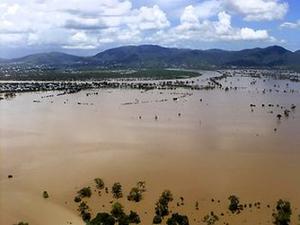DisastersAussie "inland tsunami" now threatens Brisbane
The flood zone in northern Australia covers an area larger than France and Germany combined; incessant rain and wide-spread floods have destroyed infrastructure and severely hampered economic activity; the worst is yet to come: Brisbane river has broken its banks, sparking fears that the city — Australia’s third largest and home to two million people - will be flooded by Thursday; public health experts fear that outbreaks of Ross river virus — a debilitating disease transmitted by mosquitoes, which is endemic in Queensland — will increase

Flooding seems to extend to the horizon // Source: news.com.au
Flood waters continue to cause chaos in northern Australia, as an overnight downpour created an “inland tsunami”, killing at least thirteen people.
The worst is yet to come. Brisbane river has broken its banks, sparking fears that the city – Australia’s third largest and home to two million people – will be flooded by Thursday.
And the trouble won’t be over even when the floods subside. Public health experts fear that outbreaks of Ross river virus – a debilitating disease transmitted by mosquitoes, which is endemic in Queensland – will increase. New Scientist reports that a wall of water up to 2-meters high surged through Toowoomba (see video) and the Lockyer Valley in Queensland yesterday, killing at least thirteen people, overturning cars, and demolishing buildings.
The water now threatens Brisbane. Normally it is protected from periodic flooding of the Brisbane river by the Wivenhoe dam, eighty kilometers away.
Wivenhoe is already 81 percent over capacity, however, after last month’s heavy rains saturated Queensland.
To save Brisbane from flooding, officials began releasing water from Wivenhoe last month. Because of the inland tsunami now hurtling toward the city, officials have increased the amount of water released from 140 million tons Monday to 344 million tons Tuesday.
“With the whole catchment now in a state of complete saturation, any subsequent rainfalls… will likely result in extreme run-off events as we have seen in Toowoomba and the Lockyer Valley,” says Tony Weber, an environmental engineer specializing in catchment assessments at the Australian National University (ANU) in Canberra.
He says the ground needs time to dry to avoid further flooding, and this could take weeks – assuming there is no further rainfall.
Tony McMichael, an epidemiologist at ANU, says that after the floods “there is an increased risk of outbreaks of Ross river virus”, which is endemic in Queensland. The mosquito-borne RNA virus causes Ross river fever, a non-lethal but debilitating disease. In these warm and humid conditions “mosquito populations will have much greater breeding opportunities”, he says.
